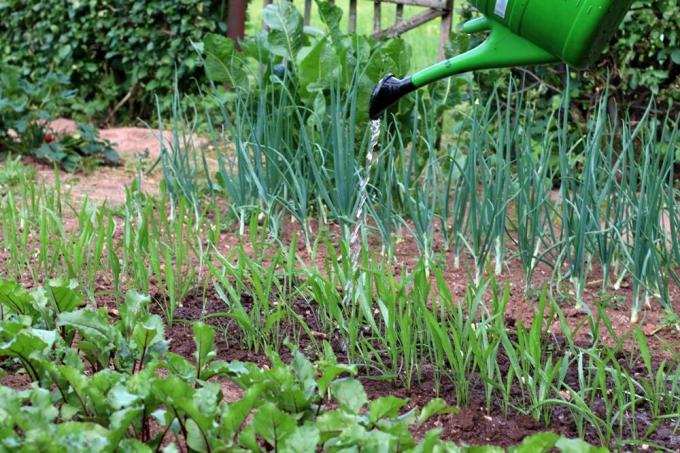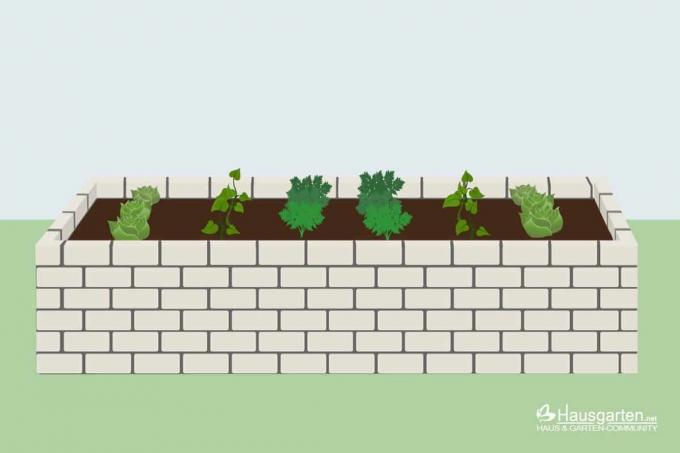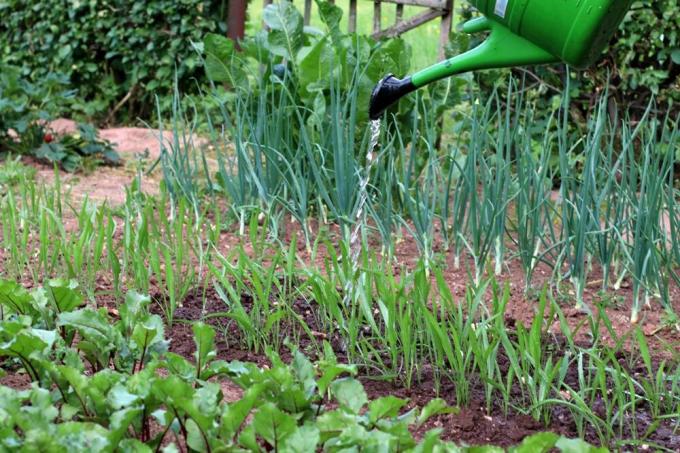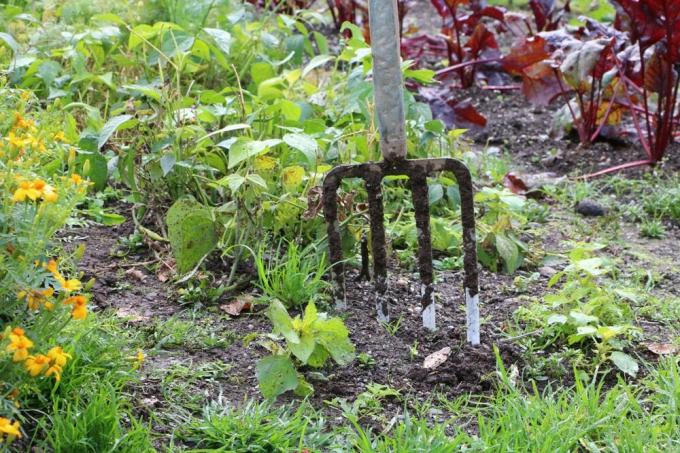

Table of contents
- ways
- main ways
- cobblestones
- grid stones
- crushed stone/gravel
- delimitations
- additions
- care pathways
- More tips
- use of leftovers
- Care
Anyone who grows vegetables in their own garden in summer usually does so in beds. In order to be able to reach the beds for watering the plants, weeding or harvesting, appropriate access is usually required. After all, it makes little sense to walk through a well-tended bed. As a result, paths are needed that make it easier, among other things, to care for the plants.
ways
Yes, a vegetable garden also needs to be planned - at least if you want to grow more than just one or two types of vegetables. When planning, the first thing to do is of course the beds, their position and size. However, one should not forget that the beds must of course also be reached. This requires ways. Basically, three types of paths can be distinguished:
- main ways
- additions
- care pathways
Main roads are like the main thoroughfares in a vegetable garden. For example, you can use them to bring a wheelbarrow as close as possible to a bed. Access points can be understood as branching off from a main path, which lead from there directly to the bed. Finally, care paths are those very small paths on which you can move within the bed without having to step on plants. How many of these individual paths are required depends, of course, on the size of the vegetable garden or depending on the number of beds. What all types of paths have in common is that they should make accessibility easier. And if possible, they should also look good.
Tip:
When creating a new vegetable garden, it is advisable to draw a plan in which the number of beds is recorded. Based on this, the paths actually required can be derived.
main ways
As already indicated, the main path or paths are the central supply artery in the vegetable garden. It makes sense if, for example, they lead directly to a device shed or to the compost. Since heavier garden equipment is usually transported on these paths, they should definitely be secured. Adequate width is also important. It should be at least 60 cm. Main routes can be designed in many ways. There are hardly any limits to your own creativity. Here are a few ideas and basic options:
cobblestones
A paved path guarantees that you will get exactly where you want to go with dry feet and very safely. It is therefore advisable to pave the main path in the vegetable patch, because then it can be used with a wheelbarrow, for example, even when it is wet. For the paving, however, an excavation of the path and then a stable substructure is required first, on which the stones come to rest. The type of paving stones you choose depends on your personal taste and budget. Slabs made of natural stone or aggregate concrete are recommended. In any case, attractive visual accents can be set with both materials. Disadvantage: Another sealing of the floor.
Tip:
Washed concrete slabs can be painted in all conceivable colors very easily. As a result, such a path can then be designed extremely individually.
grid stones

In order to largely avoid soil sealing, you can use so-called lattice stone. On the one hand, they form a stable path that can also be used when it is wet, but on the other hand, through their openings, they ensure that the water can drain into the ground. Lattice blocks are now available in countless shapes, colors and designs in hardware stores. Incidentally, a substructure is also absolutely necessary for them.
crushed stone/gravel
A path can also be paved very reliably with crushed stone or gravel. Both materials also look very natural and natural. Gravel is available in many different grain sizes and colors. This means that a wide range of design options are no longer a problem. The disadvantage of both building materials, however, is that the path has to be maintained much more frequently.
Concrete:
The stones have to be smoothed over and over again.
delimitations
It makes sense not only to fortify the main path, but also to delimit it from the beds. In this context, one likes to speak of a path or bed edging. On the one hand, this ensures that the fertile soil of the beds cannot get on the path, and on the other hand, prevents you from accidentally stepping into the beds or with a wheelbarrow rolls. In the meantime, there are also countless variants when it comes to path borders. Elongated stone slabs are just as important as small stone walls or wooden palisades. The latter are particularly recommended because they look extremely natural. The palisades are simply hammered into the ground with the pointed side. The situation is similar with sheet metal. Rocks, on the other hand, are best rested on a foundation.
additions
As branches off the main path, the entrances lead directly to the bed. They can, but do not have to be attached. A grass path would also be possible, for example, which would then ideally fit into the natural setting. But a sand or gravel path is also conceivable. Of course, there is nothing wrong with paving the entrances. Only an additional seal should be avoided if possible. If the main path has a path enclosure, the branches to the access points must of course remain free, otherwise you regularly have to overcome a completely unnecessary barrier. Incidentally, the width of the access plays a subordinate role. The important thing is that you can move safely and comfortably on it.
care pathways
The care paths lead right into the bed. They make it possible to work directly on the individual plants and, of course, to harvest them. A width of around 15 to 20 cm is usually sufficient for this. They are best planted by patting the soil in a straight line between the rows of plants. In most cases, a single maintenance path is sufficient, which then completely cuts through the bed. It makes sense that the path is a little lower than the heaped up planting area. You should also move with a certain amount of caution on it, so as not to damage any plants. A special design is not recommended. Functionality is what counts here. Design elements can very quickly become a hindrance.
More tips

The paths in the vegetable garden do not necessarily have to be dead straight. The main path, for example, can also be designed very well, for example in a wavy line. However, this requires significantly more effort and of course also has an impact on the shape of the beds. But who says that they always have to be in the shape of a rectangle? Why not experiment with other shapes?
use of leftovers
For the design of the main path and the entrances, it makes sense to use material leftovers, for example from the paving of the garage entrance. This not only saves costs, but also conserves resources. Stones that have already been used can also be used wonderfully for this purpose. However, it is advisable to clean them thoroughly beforehand. Incidentally, old roof tiles, which are carefully hammered into the ground with a rubber mallet, can also be used to border the path. Old wooden planks and square timber are also suitable for this.
Care
The paths in the vegetable garden should also be maintained. The main path will almost certainly need to be swept regularly. It is also advisable to free it from weeds several times a year, which can even grow out of small intermediate joints. Otherwise, due to the natural flight of seeds, there is a risk of increased weed growth in the beds. The paths don't have to look like they have been licked, but they should always be clean. For safety reasons, it is advisable to repair any defects that may have arisen immediately.
 garden editorial
garden editorial I write about everything that interests me in my garden.
Learn more about creating a vegetable garden

Build your own raised bed out of stones: this is how it works
Building a raised bed out of stones is more complex than variants made out of wood or aerated concrete. On the other hand, they are very durable, decorative, offer decisive advantages and can even increase yields. We explain how it works here.

18 good neighbors of broccoli | mixed culture
Broccoli is a close relative of cauliflower and a great homegrown vegetable. In the vegetable garden, it is generally advisable to pay attention to good plant neighbors. A corresponding mixed culture has many advantages for all species involved.

Creating a vegetable garden for beginners – instructions incl. plan
Quite a few people today dream of harvesting their own vegetables and being self-sufficient. No wonder: you know where it comes from and what's in it. You are also a bit more independent. Of course you need a garden for that. What is important when creating a vegetable garden is here.

Planning a vegetable garden - my first small self-sufficient garden
The vegetable garden is an important first step on the way to independent self-sufficiency. In order for your self-sufficient life to get off to a good start, it depends on the right planning, from A, for cultivation area, to Z, for fence. This step-by-step guide explains how to make your first small self-sufficient garden perfect.

Choose the right film for the raised bed
Raised beds are not only a big trend, they can make growing fresh vegetables and aromatic herbs a lot easier. With a flexible choice of location, the design options are almost inexhaustible. Raised beds can be made of different materials that suffer to varying degrees from soil moisture. This requires good protection.

Creating an organic garden - tips on plants, varieties and crop rotation
Pesticide-free and sustainable: There are many reasons for cultivating an organic garden. The near-natural landscapes also offer a protected retreat for endangered plant species. Creating an organic garden is easy to do. With the right preparation, it is possible to enjoy a bountiful bloom and harvest in the summer.
